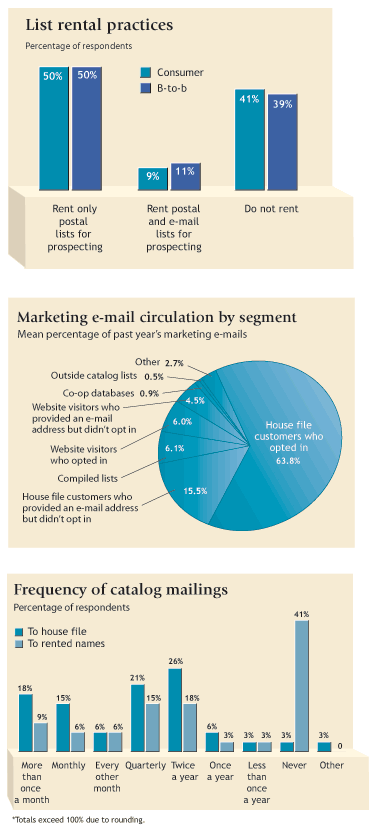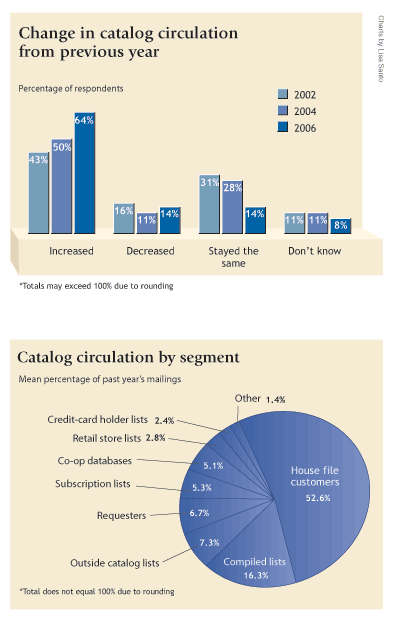There’s been a fair amount of tumult within the list industry recently (see “InfoUSA headline here tk,” page 7). But neither consolidation among providers nor the January postal rate increase seems to have led catalogers to pull back on circulation or prospecting.
For instance, nearly two-thirds (64%) of respondents said that they’d increased circulation this year over last year. That’s up from 50% of respondents to the previous survey, conducted in 2004. Among those 64%, the mean increase in total circulation was 7%. But the plurality of respondents — 39% — said that their 2006 catalog circ was up more than 10% from 2005.
What’s more, 63% of survey respondents said they were increasing mailings to outside names. That’s up from fewer than half of the respondents two years ago.

Interestingly, that increase in prospecting circulation comes despite a decline in the percentage of respondents who rent lists for prospecting. Among consumer respondents, 59% rent lists, down from 69% of the consumer respondents in 2004. On the business-to-business side, however, 61% rent lists for prospecting, up 3 percentage points from 58% in 2004.
A full half of the respondents who rent lists for prospecting handle brokerage inhouse with the assistance of an outside list firm. Another 42% rely exclusively on an outside brokerage; the remaining 8% handle all their brokerage needs inhouse. A third of the respondents who use outside brokers pay a 10% commission; another third pay a 20% commission. Twenty-eight percent pay a commission of less than 10%.
The percentage of b-to-b respondents who rent or exchange their house file names has also increased. Only 12% of the b-to-b catalogers surveyed in 2004 had their lists on the market. This year 48% of the b-to-bers said their lists are available.

But among consumer catalog respondents, the trend has reversed. Fifty percent of this year’s consumer participants have their house file available for rent or exchange, down from 59% two years ago.
Of those respondents who rent or exchange their house file, nearly all — 89% — rent to noncompetitors, while only 32% rent to competitors. They’re more likely to exchange with competitors: 63% said they do so, while 58% exchange with noncompetitors.

Renting e-mailing names for prospecting is nowhere near as widespread. Only 12% of respondents said they do so. And only a mean 0.5% of respondents’ marketing e-mails went to names rented from or exchanged with other catalogers; another 0.9% were sent to names from cooperative databases. The mean percentage of marketing e-mails sent to names from compiled lists did rise somewhat, however, to 6.1% from 4.3% among respondents in 2004.
The mean percentage of marketing e-mails sent to Website visitors declined during the past two years. Among the participants in the 2004 survey, Website visitors who weren’t buyers but who had opted in accounted for a mean 16.4% of e-mails sent; this year they accounted for just 6.0%. Likewise, two years ago a mean 13.3% of marketing e-mails were sent to Website visitors who provided an e-mail address but did not specifically opt in (the so-called implied opt-in), compared with 4.5% this year. The lion’s share of marketing e-mails went to customers who had specifically opted in: a mean 63.8%, up from 55.4% two years ago. Customers with an implied opt-in accounted for a mean 15.5% of marketing e-mail circulation, all but flat with 2004’s 16.4%.
METHODOLOGY
On March 28, 2006, Prism Business Media e-mailed an invitation to participate in an online survey to 3,007 subscribers of Multichannel Merchant with the job function of president/owner, vice president, marketing management, or list management. A link was included on the invitation to route respondents directly to the questionnaire. Respondents were offered the chance to win one of four $50 Amazon.com gift certificates. Follow-up e-mails were sent on April 4, April 11, and April 20. Of the 2,353 deliverable surveys, 47 were completed, for an effective response rate of 2.0%.